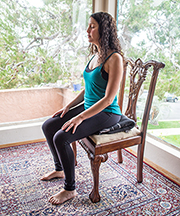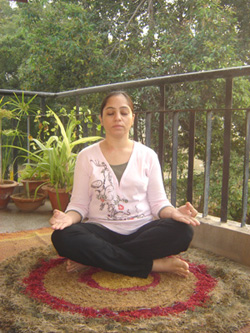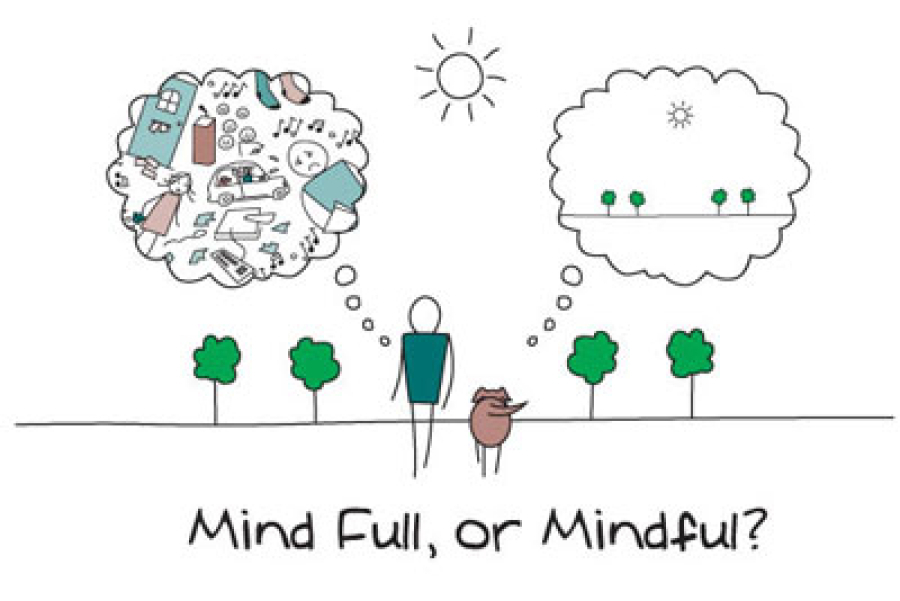Mindfulness and Meditation
Why Mindfulness in Meditation?
Practising mindfulness can enable us to overcome suffering and to recognise natural wisdom and we can develop mindfulness through meditation. There are many forms of meditation – some can induce altered states of consciousness and others just help us to relax. Mindfulness meditation is not aimed at changing us, but instead helps us to be more aware of what is ‘true’ and to be totally ‘present’ in the moment, no matter what is happening. We want to tune in to this natural wisdom to suffer less and although this would appear to be making changes, it is rather that going more deeply into the present moment and into ourselves as we are already, will make us more aware of our inherent wakefulness.
‘The thing about meditation is: you become more and more you’ David Lynch
 The sitting practise of mindfulness meditation can give us exactly that – making us more ‘present’ with ourselves just as we are, which will enrich our inherent wisdom and teaches us how to escape the discomfort or pain we will always, as humans, experience simply by being alive. Buddha taught us that the source of suffering is our attempt to escape from our direct experience – firstly we cause our suffering by trying to escape pain and trying to hold on to pleasure, but instead of making us happier, it creates suffering – and secondly, we suffer when we attempt to support our ego, which also doesn’t work and leads to more suffering.
The sitting practise of mindfulness meditation can give us exactly that – making us more ‘present’ with ourselves just as we are, which will enrich our inherent wisdom and teaches us how to escape the discomfort or pain we will always, as humans, experience simply by being alive. Buddha taught us that the source of suffering is our attempt to escape from our direct experience – firstly we cause our suffering by trying to escape pain and trying to hold on to pleasure, but instead of making us happier, it creates suffering – and secondly, we suffer when we attempt to support our ego, which also doesn’t work and leads to more suffering.
Instead, with mindfulness, we do not try to escape from difficult experiences, but merely give precise, nonjudgmental attention to them and practise being able to be with them. It is paramount to bring mindfulness to good experiences too, as many of us struggle with simply staying ‘present’ with happiness, turning it into worry it won’t last or trying to hold on to it.
Being mindful ensures we are ‘present’ for every part of our life – not missing experiences due to distraction or wanting things to be different. Instead, being ‘present’ allows us to understand what is necessary when we need to change something. Mindfulness does not replace actually taking part in our life and taking care of our, and others’, needs – in fact the more mindful we become, the more compassionate we can be.
Learn about 5 benefits of mindful meditation!
There many good reasons for us to practise mindfulness meditation and these are five persuasive arguments, which research has shown us, can enrich our lives:
- Helps to understand our pain – pain is a fact of life, but we do not need to allow it to take over our life. Mindfulness can help us adapt our relationship with mental and physical pain.
- Helps us to better connect in our relationships – there will be times when we
 have all found ourselves staring blankly at a friend, colleague, child etc with little idea of what they have just said! Mindfulness can help us give our full attention.
have all found ourselves staring blankly at a friend, colleague, child etc with little idea of what they have just said! Mindfulness can help us give our full attention. - Promotes reduction of stress – we all know that excess stress can cause many illnesses and make existing illnesses worse. Mindfulness can greatly help reduce stress.
- Focuses our mind – it can be very difficult to concentrate when our mind is constantly wandering. Mindfulness meditation will refine our ability to focus.
- Reduces brain chatter – how often do we hear that nagging, nattering voice in our head? Mindful meditation can help us give that voice a break!
‘You are the sky – everything else is just the weather’ Pema Chödrön
Discover the 3 basic ways we can practise Mindfulness Meditation
There are many diverse, simple techniques, but there are three basic aspects: body, breath and thoughts.
- The body – firstly we use an eyes-open practise to allow us to allow what we have in front of us to be part of the practise. We choose a quiet space where there are not too many distractions like the tv or computer – if we wish, we can light candles and incense and even have a small altar of some kind. Next, we pick our seat – it’s ok to either sit on a cushion on the floor (it helps to use a cushion designed for meditation like a zafu), or on a chair.
 If we choose a chair, ensure it doesn’t tilt back too much and if our legs are dangling we should put something on the floor for our feet to rest on. We also need to ensure that our hips are higher than our knees with a cushion, otherwise our back will soon begin to hurt. Take an upright, but not rigid posture, with the back straight, but with the natural curve in the lower back. If we are sitting on a cushion, simply cross the legs comfortably in from
If we choose a chair, ensure it doesn’t tilt back too much and if our legs are dangling we should put something on the floor for our feet to rest on. We also need to ensure that our hips are higher than our knees with a cushion, otherwise our back will soon begin to hurt. Take an upright, but not rigid posture, with the back straight, but with the natural curve in the lower back. If we are sitting on a cushion, simply cross the legs comfortably in from  of you. Again – we need our hips to be higher than our knees, so if necessary add more height to the cushion. Hands rest on thighs, palms down and our gaze rests on the floor in front about 4 feet away. The gaze is not tightly focused, but just resting on the floor. Begin by just sitting for a few minutes – our attention will wander: that’s part of what we will notice with our mindfulness – but when we become aware that ours has wandered, we gently bring ourself back to the ‘present’.
of you. Again – we need our hips to be higher than our knees, so if necessary add more height to the cushion. Hands rest on thighs, palms down and our gaze rests on the floor in front about 4 feet away. The gaze is not tightly focused, but just resting on the floor. Begin by just sitting for a few minutes – our attention will wander: that’s part of what we will notice with our mindfulness – but when we become aware that ours has wandered, we gently bring ourself back to the ‘present’. - The breath – rest our attention lightly on our breath, feeling as it goes into our body and as it goes out. We are not trying to control our breath, as we are just interested in how we already are, but if we find that we are – as the mere fact of thinking about it can sometimes make us do it – then we just let it be however it is. Again, we sit for a few minutes. In and out…in and out. We will be focusing about 25% of our attention on our breath and the rest on our body and our surroundings.
- Our thoughts – as we sit practising, we will notice thoughts arise. Sometimes, there will be a big jumble, tumbling over each other; memories, future plans, fantasies,
 even maybe a chorus of a song! There may be no gaps at all where we can notice our breath, but that’s not unusual, particularly when new to meditation. Just notice everything that happens and when we become aware that the thoughts have taken over and we have forgotten where we are, just gently bring ourself back to our breath again. We can silently say ‘thinking’ to remind ourself of what just happened, but we are not judging – just giving a neutral observation: ‘Thinking has just occurred’
even maybe a chorus of a song! There may be no gaps at all where we can notice our breath, but that’s not unusual, particularly when new to meditation. Just notice everything that happens and when we become aware that the thoughts have taken over and we have forgotten where we are, just gently bring ourself back to our breath again. We can silently say ‘thinking’ to remind ourself of what just happened, but we are not judging – just giving a neutral observation: ‘Thinking has just occurred’
When we are new to this practise we should try to sit for 10 to 15 minutes, gradually increasing to 20 or 30 minutes. Eventually, we can extend it to 45 to 60 minutes, but then we may wish to learn how to do walking meditation, which is detailed as follows.
‘We should sit in meditation for twenty minutes every day – unless we’re too busy – then we should sit for an hour’ Old Zen adage
Antique design Tibetan Singing Bowl set
Guided Mindfulness Meditation by Jon Kabat-Zinn (CD)
Mindfulness meditation books by Alfred James
2 simple mindfulness meditation exercises to try!
- Simple walking, mindful meditation
Most of us walk everyday at some point in the day, whether it’s walking to work, taking the children to school or walking the dog. The very fact that walking – or whatever form of ambulation we use to get around – is so central to our lives makes it a suitable focus for mindful, meditative attention. There are many variations of walking meditation and this is one similar in pace to how we walk in everyday life:
- Stand straight, with your back upright, but not stiff. Feel how our feet are toughing the ground and keep our weight evenly distributed.
- Curl the thumb of our left hand in and wrap our fingers around it. Place it just above our belly button. Wrap our right hand around it, resting our right thumb in the crevice created between our left thumb and index finger – this will create some balance and keep our arms from swinging distractingly.

Mind Full, or Mindful?
- Drop our gaze slightly, which will help us maintain focus on our meditation, but we should still remember to pay attention to traffic lights and other people etc to avoid any accidents!
- Step out with our left foot, feeling it swing and the heel hit the ground, followed by the ball of the foot and then the toes.
- Feel the same as the right foot comes forward.
- Walk at a steady pace, slightly slower than usual, but not funereal. When our attention wanders, we should just gently bring it back to the sensations of our feet touching the ground.
Deep Zen Meditation 30-day plan
2. Loving Kindness Meditation (metta bhavana) – be kind to ourselves – right now!
We often struggle in caring for ourselves, in receiving love or believing we deserve to be happy, but to be kind to others, we need to start with ourselves first.
If we imagine all the energy we waste worrying about the future and regretting the past, comparing ourselves to others and judging ourselves – that is an enormous amount of energy! And imagine that energy gathered in and returned to us – instead of castigating ourselves in the usual patterns of self-preoocupation, stinging self-judgment and fear.

Loving Kindness Meditations bring us back to our innate potential for love and awareness, where we can cultivate love and help it flourish – the primary objective being to develop care towards ourselves to enable us to fully include others in that kindness. This loving kindness practise involves silently repeating phrases that declare good qualities to ourself and to others.
- We should begin by taking delight in our own goodness – remembering things we have done out of good-heartedness, and rejoicing in those memories to celebrate the potential for goodness we all share.

- Silently recite phrases that reflect what we wish most deeply for ourselves, such as – May I live in safety – May I have mental happiness, peace and joy – May I have physical happiness, health and freedom from pain – May I live with ease.
- We should repeat the phrases with enough space and silence between to fall into a rhythm. Focus our attention to one phrase at a time.
- When we notice that our attention has wandered, we should be kind to ourselves and let go of the distraction, gently returning to repeating the phrases without judging or disparaging ourselves.
- After a while, we should visualise ourself in the centre of a circle composed of all those who have been kind to us, or have inspired us because of their love. We have have met them, or read about them; they may be alive now, or may be an historical figure. As we picture ourselves in the middle of the circle , we should experience ourself as the recipient of all their love and attention. Gently repeating the phrases of loving kindness to ourself.

- Finally, let go of the visualisation and keep repeating the phrases for a few minutes more. Each time we do so, we are transforming our old, hurtful relationship with ourself and are moving forward, strengthened by the force of kindness.
‘Close your eyes and imagine the best version of you possible. That’s who you really are. Let go of any part of you that doesn’t believe it’ C.Assaad
Most important to remember is that mindfulness meditation is not about trying to stop thinking, but about practising being mindful of whatever happens. Many of us may believe that emptying our mind is the objective, but this is not true of mindful meditation. Therefore when we find ourselves thinking, we just need to include it into what we notice – our aim is to be ourselves as we are – not to try to change ourselves into some idea of how we think we should be.
Mindfulness meditation – Guided 10 minutes (youtube)
Mindfulness meditation self-hypnosis CD
Mindfulness Meditation to help relieve anxiety & stress (youtube)

‘Mindfulness meditation doesn’t change life. Life remains as fragile and unpredictable as ever. Meditation changes the heart’s capacity to accept life as it is. It teaches the heart to be more accommodating, not by beating it into submission, but by making it clear that accommodation is a gratifying choice’ Sylvia Boorstein
© 2017 Mindfulness4u.org All rights reserved





